5 Types of Tools for Efficient Procurement Risk Management


Procurement isn’t a stranger to risk—it’s practically part of the job description.
And today, amidst increasingly complex global supply chains, market volatility, and geopolitical tensions, that’s true more than ever.
Luckily, there has never been a greater abundance of technological solutions dedicated precisely to identifying and mitigating these risks.
In this article, we’ll explore these tools: what they are, how they work, their role in shielding against risk, and the key features they offer.
By the end of it, you’ll realize that procurement isn’t solely defined by challenges and that there are plenty of ways to boost your agility and resilience.
Let’s jump right in.
Procurement risk management software, as the name suggests, helps manage risks within the supply chain.
More specifically, it identifies, documents, assesses, classifies, mitigates, and then monitors these risks, and it does so more efficiently and effectively than any outdated manual method out there.
Amanda Cohen, VP of Product at Resolver, elaborates on why this piece of technology is so valuable to companies today.
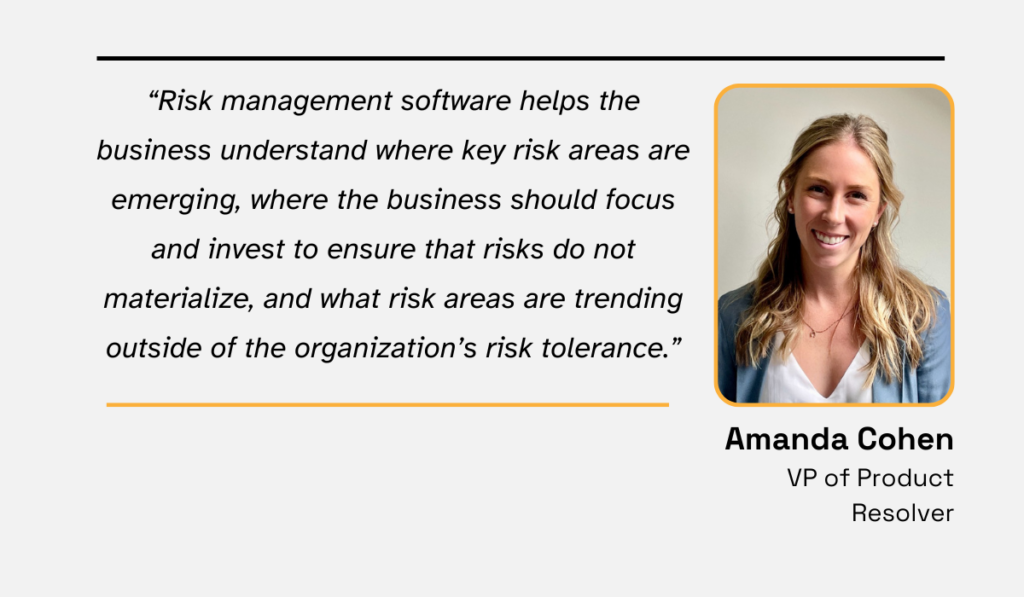
Illustration: Veridion / Quote: Resolver
She adds that, by automating cumbersome manual processes in risk management, not only do procurement professionals get a clearer view of potential dangers and disruptions, but also more time to concentrate on developing successful strategies for risk elimination.
Put simply, risk management solutions make risk identification and mitigation faster, easier, more streamlined, and, most importantly, more effective.
And now more than ever, there seems to be a great need for such technology.
According to the Business Continuity Institute survey, the commitment to supply chain risk control by top management has been steadily but surely increasing between 2016 and 2020.
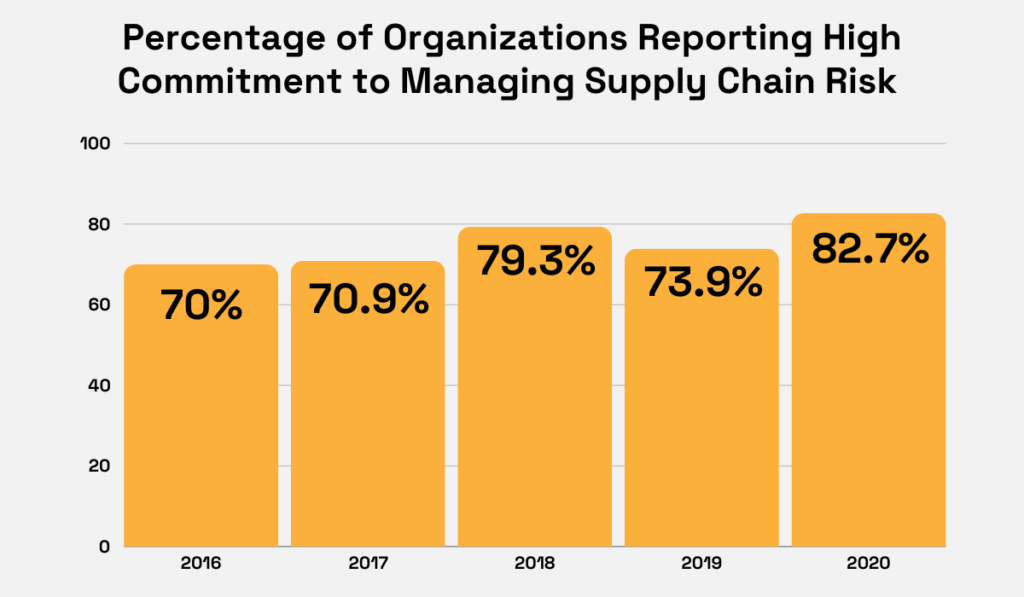
Illustration: Veridion / Data: Business Continuity Institute
This is in part due to the COVID-19 pandemic, which starkly demonstrated the fragility of supply chains and proved once and for all that companies need a strong risk control system in place in order to make it in today’s volatile market.
That’s where risk management software comes in.
It eliminates unnecessary processes, improves necessary ones, and provides a greater understanding of possible risks, making businesses much better equipped to deal with supply chain disruptions or internal operational challenges.
Now, let’s talk features.
What are some fundamental capabilities you should look for if you decide to purchase this kind of technology for yourself?
Here are just a few key examples:
| Risk Register | Organizes risks clearly, facilitating interdepartmental communication and collaboration |
| Risk Analysis Capability | Analyzes the likelihood and impact of risks, prioritizing them based on severity |
| Risk Incidents Tracking | Tracks and reports on the frequency and severity of risks, identifying patterns and trends |
| Notifications | Alerts users about upcoming tasks, incidents, changes to relevant policies, or when a risk’s impact or likelihood reaches a predetermined level |
Overall, with risk management software, you get a platform completely dedicated to accelerating identification, improving mitigation, and simplifying monitoring and documentation of risks for team members across all company departments.
As such, it’s the ultimate risk-control tool in the toolkit of any procurement professional.
There’s no denying that data is the key to successful risk control in procurement.
But to truly understand that data and turn it into usable information, you’ll need the right tool.
And that tool is data analytics platforms.
These solutions help collect, process, examine, and visualize large datasets from various sources, revealing trends, patterns, and possible risks.
In other words, they transform endless seas of information that would otherwise stay buried into actionable insights, thereby informing decision-making and risk mitigation strategies.
There are four primary types of data analytics in procurement, each described below.
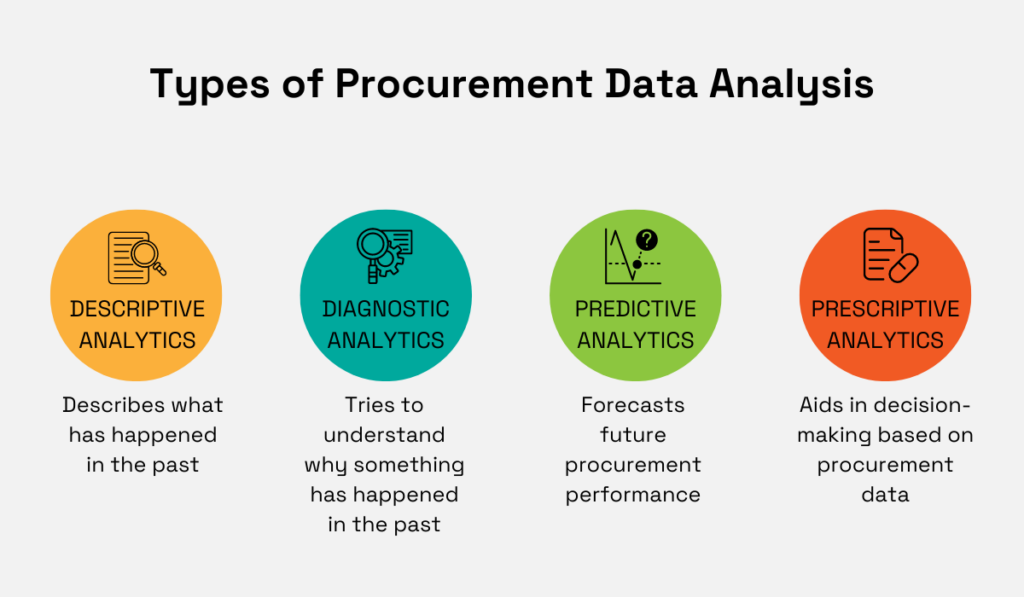
Source: Veridion
Predictive and prescriptive analytics revolutionized the approach to data analysis, paving the way for more data-driven operations than ever before.
They enable users to forecast future events, such as commodity price fluctuations or geopolitical conflicts, and provide useful advice on the most effective ways to mitigate these risks.
It’s not about understanding just the past or present anymore, but about anticipating the future and charting the optimal course of action to address it.
According to Nicolas Walden from the Hackett Group, manual methods pale in comparison to these modern analytics tools.
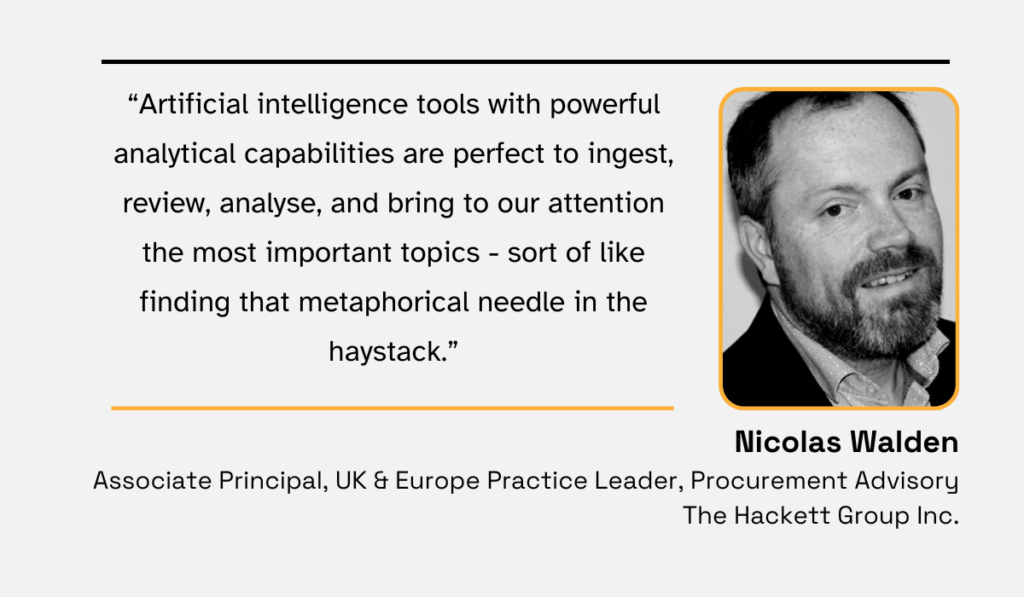
Illustration: Veridion / Quote: Procurement Magazine
He advocates for cognitive data-driven risk control powered by AI or machine learning as the most efficient way to analyze procurement data.
These technologies are able to see what humans simply can’t, offering more precision, accuracy, and detail.
This makes them ideal for effective risk management in our complex, data-centric world.
But, besides AI-powered prescriptive or predictive analytics, what are some other features you might expect from these systems?
Here are a few examples:
| Data Integration | Connects with different data sources, consolidating information in one place |
| Data Mining | Extracts knowledge from large datasets |
| Real-time Analytics | Provides up-to-date information on customer behavior, market trends, and operational performance |
| Visualization Capability | Presents complex data in visually appealing ways through interactive dashboards and charts |
| Savings Tracking | Offers a lifecycle view of all cost-saving projects |
At the end of the day, anyone is perfectly capable of compiling large volumes of data, but it’s the way we interpret and apply the data that matters the most when it comes to risk control within procurement.
Data analytics platforms are just the tool for that:
Not just sifting through vast amounts of information, but also helping you unlock its full potential and delivering data-backed recommendations—all in mere seconds.
No guesswork. Just facts.
Supplier sourcing tools are designed to help quickly identify and select suppliers that align with users’ unique requirements or criteria related to quality standards, cost competitiveness, financial stability, or sustainability practices.
They do so by granting access to rich supplier information, including financial reports, compliance records, and performance history.
This enables procurement teams to evaluate potential partners’ viability before starting a business relationship with them.
That way, supplier-related risk is reduced to a minimum from the get-go.
It’s perhaps unsurprising, then, that a significant number of procurement professionals today prioritize improving their supplier data to achieve their procurement objectives.
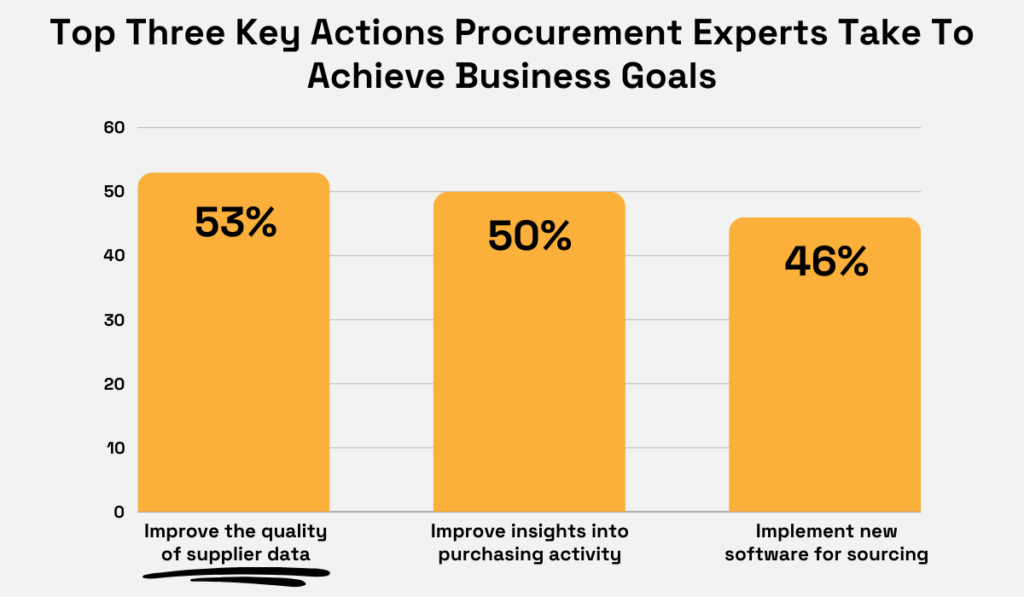
Illustration: Veridion / Data: Ivalua
They understand that robust data directly correlates with the ability to forge partnerships with reputable suppliers, in turn reducing risks associated not only with individual suppliers or vendors but also with the entire supply chain.
Now, supplier sourcing platforms are extremely fast.
According to research by McKinsey, AI-backed supplier sourcing tools can expedite the supplier selection process by up to a staggering 90% compared to manual methods.
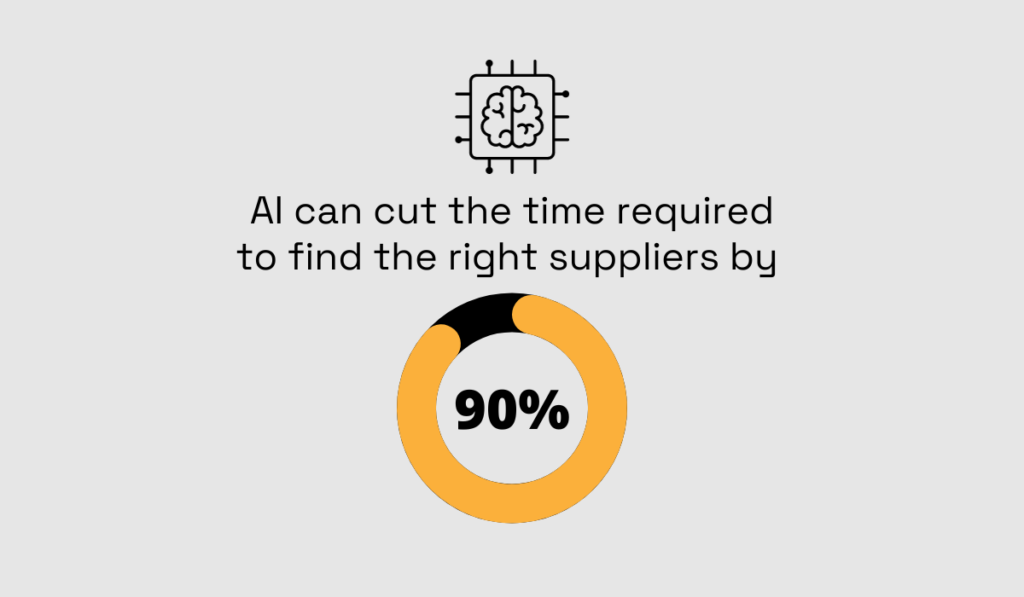
Illustration: Veridion / Data: McKinsey & Company
But these systems aren’t just quick; they are very thorough as well.
Just take Veridion, our own AI-powered supplier sourcing solution, for example.
It taps into a vast database consisting of over 60 data points for more than 80 million companies worldwide.
Plus, its real-time data ensures users are always well-informed, empowering them to adapt quickly to any changes or disruptions in the market.

Source: Veridion
Now, let’s see what specific features Veridion brings to the table:
| Supplier Risk Monitoring | Instantly notifies users of potential risks associated with suppliers, such as impending bankruptcy, enabling proactive risk management |
| Sustainable Sourcing | Enables the filtering of suppliers based on Environmental, Social, and Governance (ESG) criteria, promoting responsible and ethical sourcing practices |
| Complex Search API | Empowers users to create intricate query structures to swiftly identify suppliers that precisely match their requirements, boosting search accuracy and efficiency |
| Match & Enrich API | Ensures Supplier Master Records and Master Data Management stay up-to-date and deduplicated, providing you with an always-accurate view of your supplier landscape |
Ultimately, partnerships with suppliers should shield you from risk, not expose you to it.
However, the task of finding reliable partners can often be quite time-consuming and labor-intensive, particularly due to the relevant data being so disorganized and scattered across various sources.
Luckily, with supplier sourcing platforms like Veridion, this task becomes not just manageable, but a complete breeze.
Contract management systems track contract terms and obligations, ensure important documents are well-organized and deduplicated, enable communication across all company departments, and help monitor contract performance metrics.
As a result, these tools are extremely effective in shielding businesses from noncompliance and other risks associated with contractual agreements, such as:
What all of those issues ultimately translate into is significant trouble for companies as a whole, impacting their productivity, reputation, and profitability.
In fact, did you know that, according to research from World Commerce and Contracting, poor contract control can cost businesses up to 9% of their bottom line?
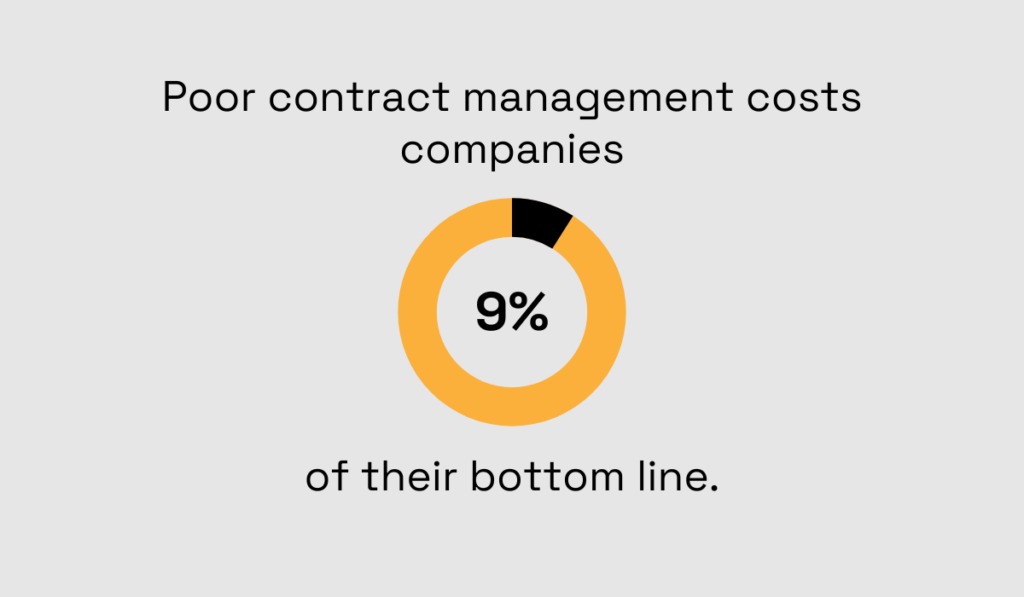
Illustration: Veridion / Data: World Commerce & Contracting
That’s certainly no pocket change.
Fortunately, all of these problems can be easily prevented with contract management systems.
They standardize contract organization, thus ensuring consistency in contract handling, reducing errors or omissions, and empowering companies to proactively meet their obligations.
Essentially, with this technology, no contractual commitment is neglected.
And businesses seem to finally understand that.
According to a survey conducted by Oneflow, 63% of companies consider contract automation essential for their operations.
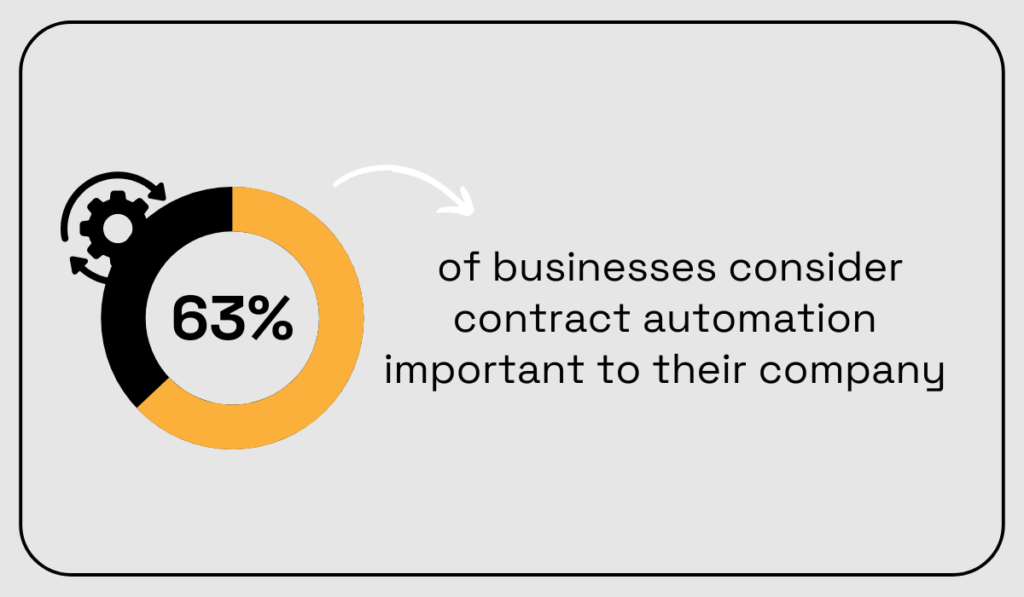
Illustration: Veridion / Data: Oneflow
And they are absolutely correct.
Handling contracts manually simply doesn’t cut it anymore, as it leaves businesses exposed to substantial risks.
So, let’s delve into some features typically offered by these systems that render them so efficient in managing critical documentation:
| Source-to-Pay Integration | Enables the creation of contracts directly from suppliers’ offers |
| Auto Alerts | Notifies users when a contract is due for review or about to expire |
| Compliance Reporting | Helps monitor contract execution and compliance based on defined KPIs |
| Smart Contract Repository | Allows quick access to any contract-related information needed |
| Collaborative Contract Authoring | Speeds up the contract creation process by enabling all stakeholders to collaborate |
Let’s face it: contract mismanagement entails a wide variety of potential risks, affecting operational, financial, reputational, as well as legal areas.
Contract management systems are a perfect solution to these risks, transforming contract control into a streamlined, automated, and standardized process, one contract at a time.
While supplier sourcing platforms help find reliable suppliers, Supplier Relationship Management (SRM) solutions ensure that these partnerships are long-lasting, productive, and profitable for all parties involved.
They achieve this by centralizing all supplier data in one place, assessing supplier performance, and facilitating collaboration between partners.
As a result, SRM users can be more confident in their business relationships, knowing they’re more resilient against risks such as quality issues, lack of trust, pricing transparency gaps, and other factors that could affect company operations and profitability.
Daniel Chua, Senior Director of Procurement at HARMAN International, agrees that buyer-supplier collaboration is extremely important, particularly in the face of unpredictable disruptions in the supply chain:
“Relationship management, for me, is key. […] If you have a good relationship with suppliers, they actually allocate more resources to support you. Procurement is all about relationship management that you build for a long time. You get returns when it is needed, not simply on a daily basis.”
Ultimately, he explains, it serves not only to meet your daily requirements but also to provide long-term protection from risk.
But for that, you need an efficient system that will help you keep tabs on those partnerships.
ProcureTech’s survey drives this point home, revealing that, for 70% of procurement professionals, improving supplier relationships is the key driver for technology adoption.
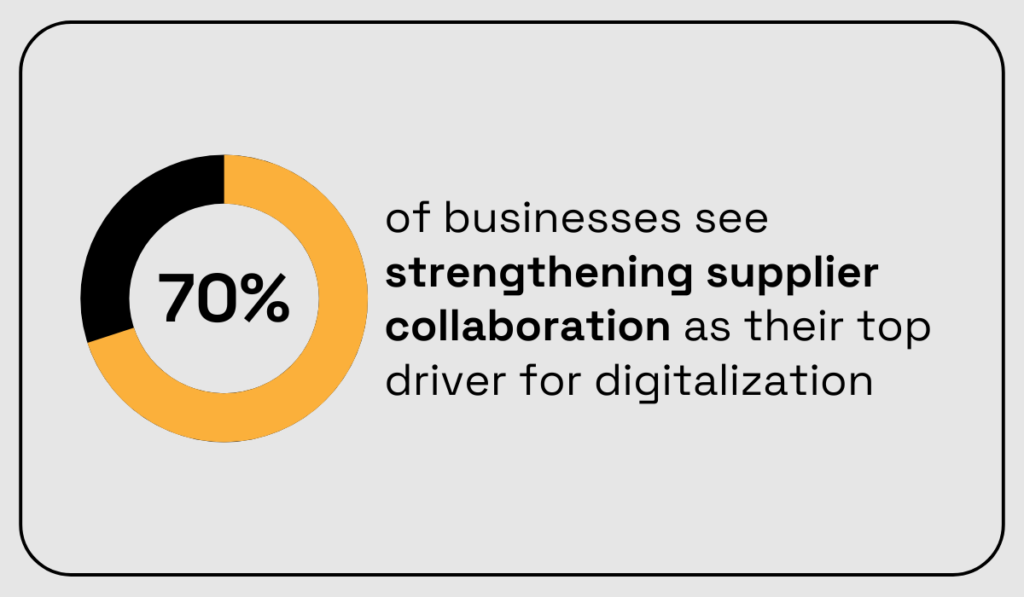
Illustration: Veridion / Data: ProcureTech
Just imagine having to manually analyze supplier performance or financial health, market trends, and other similar factors—detecting potential risks would be near impossible.
Supplier relationship management software does all of that for you, leveraging features such as:
| Supplier Data Management | Stores and tracks all relevant data, including contracts, invoices, interaction history, and certifications |
| Supplier Performance Management | Analyzes supplier performance based on predefined criteria and sends alerts for deteriorating performance |
| Risk Management | Conducts ongoing supplier compliance checks and notifies you of any potential risks |
| Supplier Contract Management | Provides templates for contract creation and monitors contract status |
Any seasoned procurement professional will tell you that forming strong alliances with suppliers is the key to resilience in procurement.
But doing so takes more than just a firm handshake and a smile.
It requires clear communication, transparency, effective feedback mechanisms, and diligent tracking of responsibilities from both parties.
And SRM solutions provide precisely that, ultimately helping you foster enduring and mutually beneficial collaborations.
We’d like to conclude this article with this: while all these tools are indeed highly effective in managing procurement risk, keep in mind that they are just that—tools.
Their efficiency ultimately depends on those using them.
So, don’t focus so much on buying the newest, most robust, and expensive software.
Instead, try to create a mindset within the team where risk assessment and mitigation are ingrained into everyday operations.
Encourage proactive identification of potential risks, provide training on risk assessment techniques, and reward those who always push for improvement.
It’s when we prioritize this commitment to risk management that these solutions truly shine, showcasing their full potential.